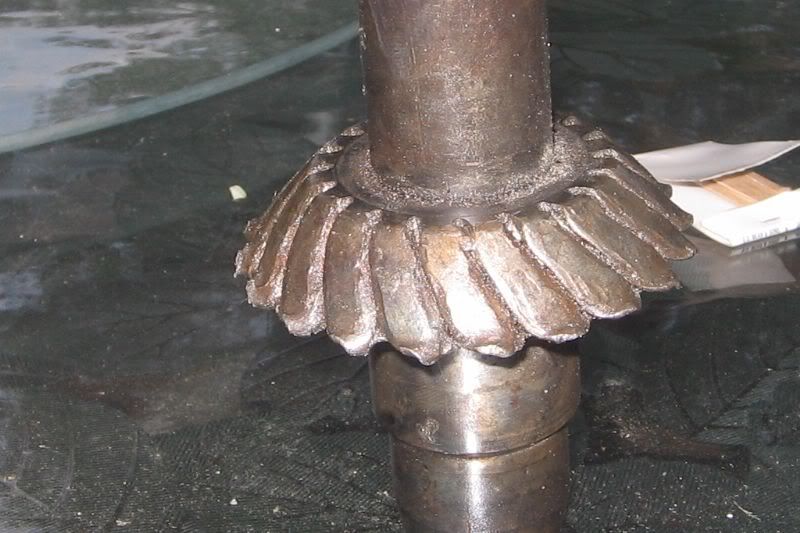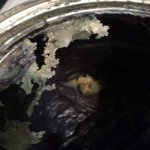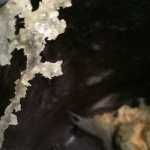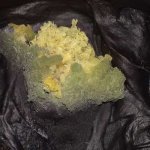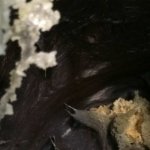facelift
Seaman Apprentice
- Joined
- Mar 20, 2013
- Messages
- 30
So here's my story...
I have scoured the forums, but have yet to come across an incident (and more specifically, a resolution) quite like my current dilemma. But I have learned a great deal in the process. Not unlike when I when I broke 5 out of 8 spark plugs on my F150. I assure you I am more intimately familiar with my 5.4 Triton motor than I ever wanted to be. Ha!
I am the second owner of a 1998 Bayliner Capri SS with a Mercruiser 3.0 lx and Alpha 1(gen 2) sterndrive. A very dear friend (RIP) was the first. The boat is a little bit older, but she is immaculate. An absolute sweetheart. Garage kept, never rode hard and put away wet. Always wiped down, cleaned, allowed to dry-out completely, and serviced regularly. The gel-coat, the interior and the motor, at least until now, pristine.
The water levels on Lake Mead where we boat keep breaking record lows. Early in the season, in the dark and in the wind, I mistook a shoal for a channel at the narrow mouth of the cove leaving the marina. The way the wind was blowing the caution buoys made them line-up perfectly, just like runway lights, like they were saying, "come right through here." Unfortunately they were saying the exact opposite and I chewed up the original aluminum prop pretty good. Well, I found what I thought was a good deal for a
Quicksilver SS on ebay. Correct number of teeth, same size and pitch, so I got it. It fit right on, and used the next 3 or 4 outings without incident. I didn't get the significant performance improvement I had hoped for though. Seemed to get on-plane a little quicker and overall maybe a little peppier, but not much. And I did notice about a 200 RPM increase across the powerband all the way through to WOT.
So flashforward to our last outing. It was a perfect day on the water. No wind and we had the place to ourselves, almost no one out there. We set up on a sandy beach, had a picnic, played in the sand, went tubing and adventuring, etc. Then on the way back to the dock it happened. I was cruising about 85% WOT on glassy, silky smooth water, motor trimmed up just a bit and crossed the tiniest little wake from a boat a mile away. Suddenly the RPM's went through the roof. 6k+! I immediately slammed it into neutral, but just as quick as everything else, the engine temp shot up. It was barely idling so I shut it off. That all took place over the span of maybe 10-15 seconds. I sat there for a minute with a sick feeling in my stomach, reassuring the kids and collecting my thoughts. I started it up. It started up fine and sounded normal, but when I put in drive, zero forward motion. Same for reverse. And it was hot so I shut it back off. At this point I'm thinking I've spun a hub. After about ten minutes I try again. This time she is tough to start, running rough when she does, and dies as soon as I attempt to put in drive. I decide that's it, I don't want to make anything worse and we begin the arduous endeavour of getting back to the dock, which is a whole other story unto itself.
So now the situation is: she starts up easily and runs great on the muffs. Cool as a cucumber like always. But as soon as I put in forward, she dies. Same for reverse. With the motor off (obviously), I can spin the prop both directions. In both forward and reverse. In forward, the prop spins counterclockwise but is tight. When I spin it clockwise, it is looser and easier to turn, but there is a rhythmic clunk, relative to how fast I spin it. Presumably, the tooth of a gear or spline not mating with each rotation. The 'clunk' is clearly coming from the vicinity of the leading edge of the bottom of the lower drive section (so just opposite, or ahead of, or in front of the prop). All of that is opposite when in reverse.
I've come here under the assumption most/many of you know far more than I do about this, so please correct me here, where I am wrong about the 'facts' or the assumptions/conclusions I draw from them. But as I understand it, first off, my prop spinning and clunking is backwards. In drive, the prop should spin clockwise and not counterclockwise. This is a righthand rotation prop. And for reference, clockwise is standing behind the boat, looking forward, turning to the right. The boat has the shift assist assembly and roller-type cutout switch. With all the messing around with it, there is no doubt all of that will have to be adjusted properly. But for the immediate problem at hand, I have both, the remote control shift cable (to the helm) and drive shift cable (to the drive) unattached. I can clearly see that the drive shift cable is not bottomed out, but the shift fork that it actuates does not rotate far enough that it is pointing 100% forward. It stops a couple degrees just short. When I spin the prop, I can see the fork bounce with each 'clunk.' If I take some channel locks and put some pressure on the fork and hold it so its points forward, then I can feel the prop lock up against the motor. But that is spinning clockwise. Shouldn't the prop not spin counterclockwise when the shift fork is aligned forward, which is drive in forward gear?
I don't believe the problem is in the linkage because if I hold the shift fork in position and put some force on the prop, it will still 'clunk' on past. It just takes a significant amount of more force to do. Holding fork vs not, that is. I think for whatever reason, that clutch, or dog clutch if you prefer, just will not engage. I think I can rule everything else out, largely in part due to the fact she runs cool on the muffs. That means that impeller is spinning which means she is intact at least to as far as the lower. She runs smooth, no vibration and I can see the coupler spinning. All the cables and cable adjustments are just a means to eventually turn that shift fork, so I've cut out the middleman and gone straight to the supplier on that.
All this means my problem lie in the lower portion of the stern drive. Is that correct? If so, what then is the best course of action? Rebuild? Buy rebuilt? Buy used? I'm a fairly handy guy and got a couple of tools, so unless there's something I should be warned about or some specialized tools required, I think I can tackle tearing into it. I'm just wondering from a cost perspective, what makes most sense?
Oh, and per the prop shop, we can rule out spun hub. And it might be worth note, that I said I 'thought' I got a good deal on prop, because turns out there is quite a bit of cupping and material missing. They probably ground it down to 'pretty it up' for a sucker like me. Explains the nonexistent increase in performance stepping up to stainless. As well as the increase in RPM.
So here is the scenario I kinda see in my head....I'm cruising along at a good clip, motor trimmed up a little on a prop that is probably already ventilating/cavitating a little. When I cross that wake, the prop comes too near the surface and she breaks free. That's my RPM shooting through the roof. But just like throwing a broom stick in the spokes of some body's front bicycle wheel (if that image made you grin, you're evil. you know who you are), somethings gotta give when she comes back down and the water grabs hold of the prop again. And what gave was the inside of the lower portion of my sterndrive. Does that sound about right to anyone else? Sure makes sense in my mind, except for one little nagging bit of evidence.......
.....there was not one speck the size of a grain of sugar sand of metal of any sort whatsoever in that drive oil. ZERO. No colored bands or foam either. Nothing but that pretty quicksilver greenish blue. I THOROUGHLY dredged that oil with a strong magnet. I even drug the magnet slowly on the drive, working towards the drain hole. Nothing. No metal. No water.
I should also mention one of the things I learned in all this research, which I have never done, is that the new oil should be added bottom-up. Pumped in the drain hole. Silly me, I always thought when changing pretty much any fluid, drain from the bottom and fill back up from the top. But if this were a factor, seems it would manifest itself in the form of bits of metal in the drained out oil.
So that's it. That's about the most comprehensive account of the event, the state of the vessel before and after the event, and the specs of the vessel that I can come up with. As well the troubleshooting done thus far. Where do I go from here? I would be quite grateful to hear yall's thoughts & advice.
Kind regards,
JP
I have scoured the forums, but have yet to come across an incident (and more specifically, a resolution) quite like my current dilemma. But I have learned a great deal in the process. Not unlike when I when I broke 5 out of 8 spark plugs on my F150. I assure you I am more intimately familiar with my 5.4 Triton motor than I ever wanted to be. Ha!
I am the second owner of a 1998 Bayliner Capri SS with a Mercruiser 3.0 lx and Alpha 1(gen 2) sterndrive. A very dear friend (RIP) was the first. The boat is a little bit older, but she is immaculate. An absolute sweetheart. Garage kept, never rode hard and put away wet. Always wiped down, cleaned, allowed to dry-out completely, and serviced regularly. The gel-coat, the interior and the motor, at least until now, pristine.
The water levels on Lake Mead where we boat keep breaking record lows. Early in the season, in the dark and in the wind, I mistook a shoal for a channel at the narrow mouth of the cove leaving the marina. The way the wind was blowing the caution buoys made them line-up perfectly, just like runway lights, like they were saying, "come right through here." Unfortunately they were saying the exact opposite and I chewed up the original aluminum prop pretty good. Well, I found what I thought was a good deal for a
Quicksilver SS on ebay. Correct number of teeth, same size and pitch, so I got it. It fit right on, and used the next 3 or 4 outings without incident. I didn't get the significant performance improvement I had hoped for though. Seemed to get on-plane a little quicker and overall maybe a little peppier, but not much. And I did notice about a 200 RPM increase across the powerband all the way through to WOT.
So flashforward to our last outing. It was a perfect day on the water. No wind and we had the place to ourselves, almost no one out there. We set up on a sandy beach, had a picnic, played in the sand, went tubing and adventuring, etc. Then on the way back to the dock it happened. I was cruising about 85% WOT on glassy, silky smooth water, motor trimmed up just a bit and crossed the tiniest little wake from a boat a mile away. Suddenly the RPM's went through the roof. 6k+! I immediately slammed it into neutral, but just as quick as everything else, the engine temp shot up. It was barely idling so I shut it off. That all took place over the span of maybe 10-15 seconds. I sat there for a minute with a sick feeling in my stomach, reassuring the kids and collecting my thoughts. I started it up. It started up fine and sounded normal, but when I put in drive, zero forward motion. Same for reverse. And it was hot so I shut it back off. At this point I'm thinking I've spun a hub. After about ten minutes I try again. This time she is tough to start, running rough when she does, and dies as soon as I attempt to put in drive. I decide that's it, I don't want to make anything worse and we begin the arduous endeavour of getting back to the dock, which is a whole other story unto itself.
So now the situation is: she starts up easily and runs great on the muffs. Cool as a cucumber like always. But as soon as I put in forward, she dies. Same for reverse. With the motor off (obviously), I can spin the prop both directions. In both forward and reverse. In forward, the prop spins counterclockwise but is tight. When I spin it clockwise, it is looser and easier to turn, but there is a rhythmic clunk, relative to how fast I spin it. Presumably, the tooth of a gear or spline not mating with each rotation. The 'clunk' is clearly coming from the vicinity of the leading edge of the bottom of the lower drive section (so just opposite, or ahead of, or in front of the prop). All of that is opposite when in reverse.
I've come here under the assumption most/many of you know far more than I do about this, so please correct me here, where I am wrong about the 'facts' or the assumptions/conclusions I draw from them. But as I understand it, first off, my prop spinning and clunking is backwards. In drive, the prop should spin clockwise and not counterclockwise. This is a righthand rotation prop. And for reference, clockwise is standing behind the boat, looking forward, turning to the right. The boat has the shift assist assembly and roller-type cutout switch. With all the messing around with it, there is no doubt all of that will have to be adjusted properly. But for the immediate problem at hand, I have both, the remote control shift cable (to the helm) and drive shift cable (to the drive) unattached. I can clearly see that the drive shift cable is not bottomed out, but the shift fork that it actuates does not rotate far enough that it is pointing 100% forward. It stops a couple degrees just short. When I spin the prop, I can see the fork bounce with each 'clunk.' If I take some channel locks and put some pressure on the fork and hold it so its points forward, then I can feel the prop lock up against the motor. But that is spinning clockwise. Shouldn't the prop not spin counterclockwise when the shift fork is aligned forward, which is drive in forward gear?
I don't believe the problem is in the linkage because if I hold the shift fork in position and put some force on the prop, it will still 'clunk' on past. It just takes a significant amount of more force to do. Holding fork vs not, that is. I think for whatever reason, that clutch, or dog clutch if you prefer, just will not engage. I think I can rule everything else out, largely in part due to the fact she runs cool on the muffs. That means that impeller is spinning which means she is intact at least to as far as the lower. She runs smooth, no vibration and I can see the coupler spinning. All the cables and cable adjustments are just a means to eventually turn that shift fork, so I've cut out the middleman and gone straight to the supplier on that.
All this means my problem lie in the lower portion of the stern drive. Is that correct? If so, what then is the best course of action? Rebuild? Buy rebuilt? Buy used? I'm a fairly handy guy and got a couple of tools, so unless there's something I should be warned about or some specialized tools required, I think I can tackle tearing into it. I'm just wondering from a cost perspective, what makes most sense?
Oh, and per the prop shop, we can rule out spun hub. And it might be worth note, that I said I 'thought' I got a good deal on prop, because turns out there is quite a bit of cupping and material missing. They probably ground it down to 'pretty it up' for a sucker like me. Explains the nonexistent increase in performance stepping up to stainless. As well as the increase in RPM.
So here is the scenario I kinda see in my head....I'm cruising along at a good clip, motor trimmed up a little on a prop that is probably already ventilating/cavitating a little. When I cross that wake, the prop comes too near the surface and she breaks free. That's my RPM shooting through the roof. But just like throwing a broom stick in the spokes of some body's front bicycle wheel (if that image made you grin, you're evil. you know who you are), somethings gotta give when she comes back down and the water grabs hold of the prop again. And what gave was the inside of the lower portion of my sterndrive. Does that sound about right to anyone else? Sure makes sense in my mind, except for one little nagging bit of evidence.......
.....there was not one speck the size of a grain of sugar sand of metal of any sort whatsoever in that drive oil. ZERO. No colored bands or foam either. Nothing but that pretty quicksilver greenish blue. I THOROUGHLY dredged that oil with a strong magnet. I even drug the magnet slowly on the drive, working towards the drain hole. Nothing. No metal. No water.
I should also mention one of the things I learned in all this research, which I have never done, is that the new oil should be added bottom-up. Pumped in the drain hole. Silly me, I always thought when changing pretty much any fluid, drain from the bottom and fill back up from the top. But if this were a factor, seems it would manifest itself in the form of bits of metal in the drained out oil.
So that's it. That's about the most comprehensive account of the event, the state of the vessel before and after the event, and the specs of the vessel that I can come up with. As well the troubleshooting done thus far. Where do I go from here? I would be quite grateful to hear yall's thoughts & advice.
Kind regards,
JP




















